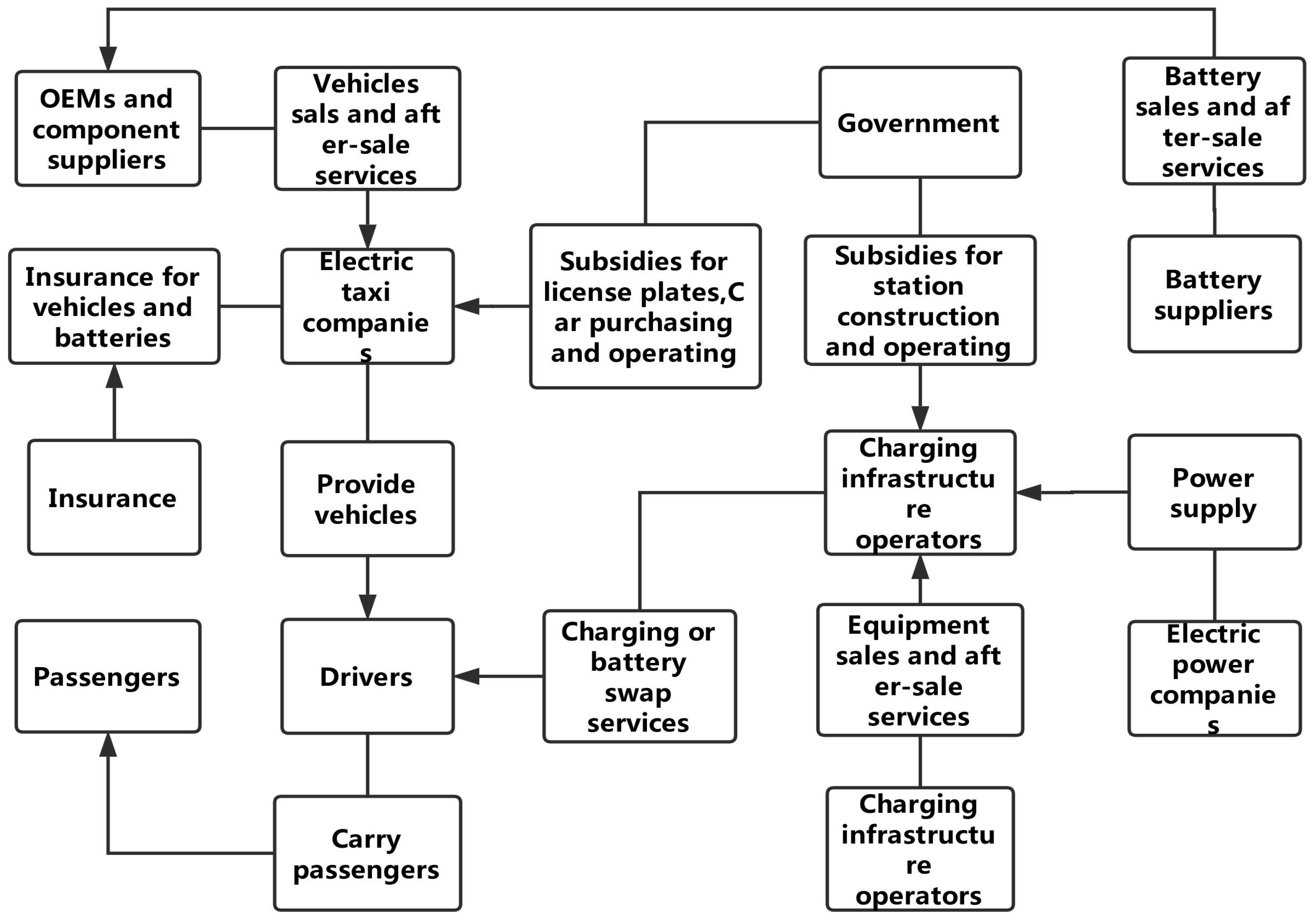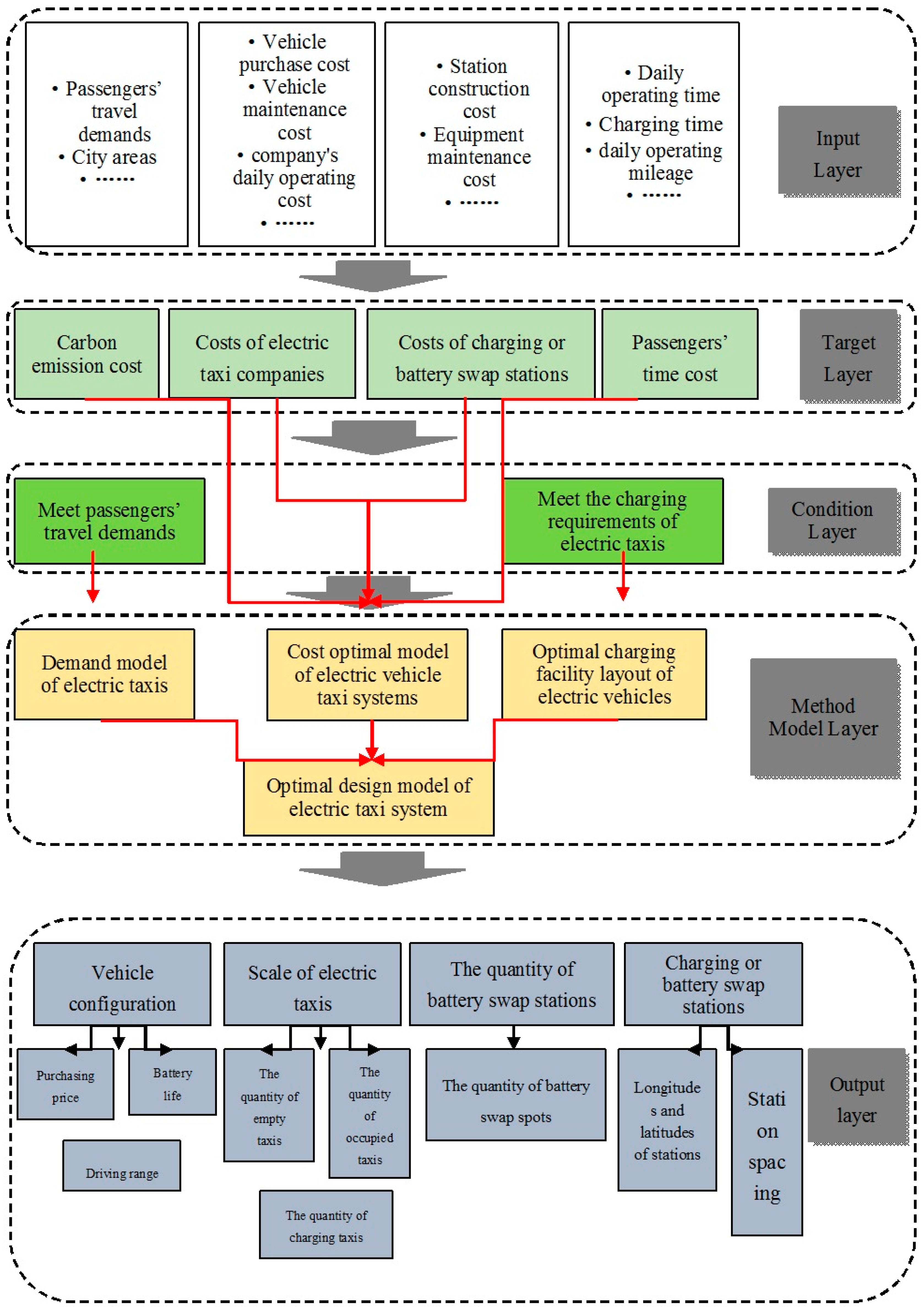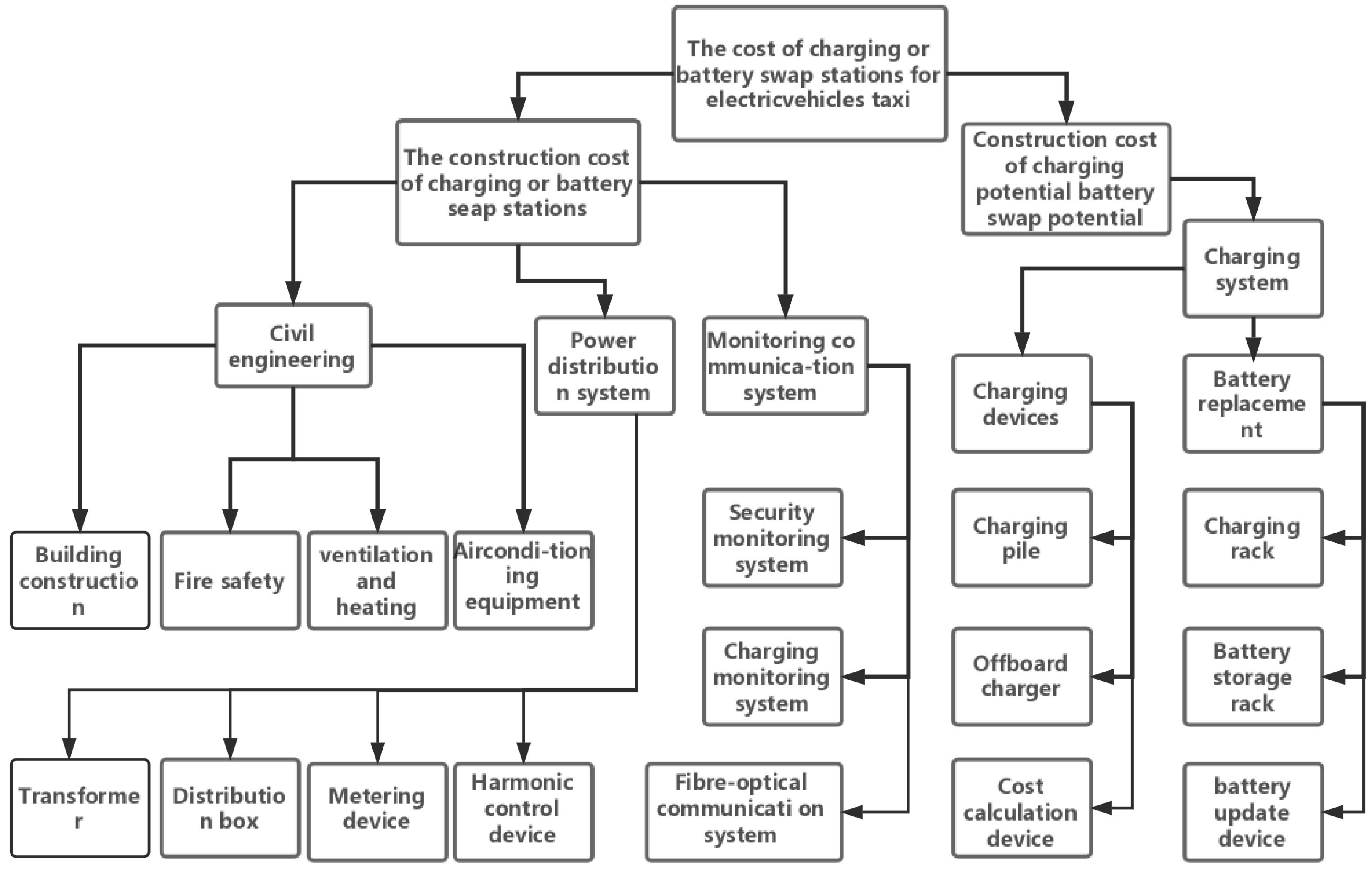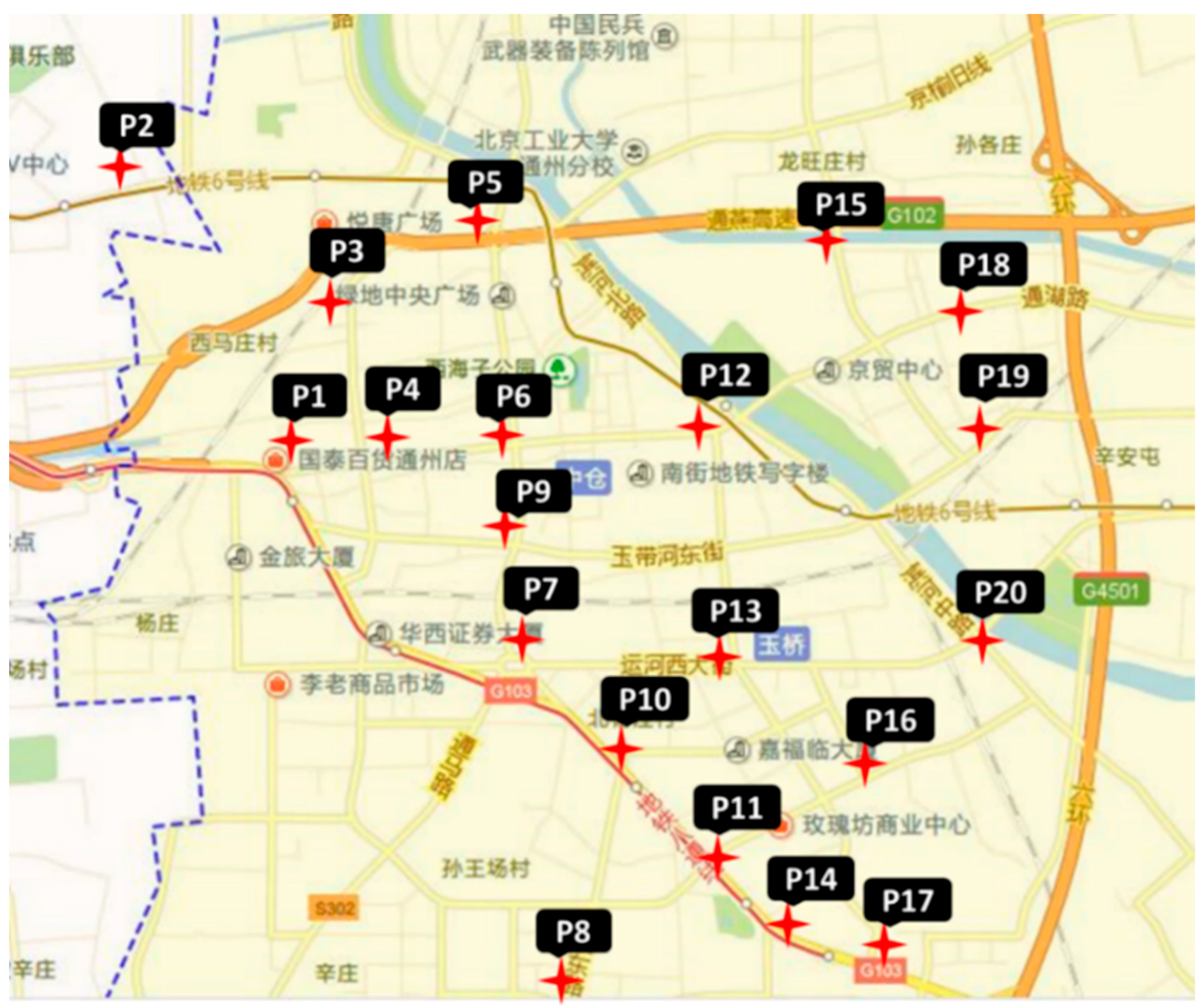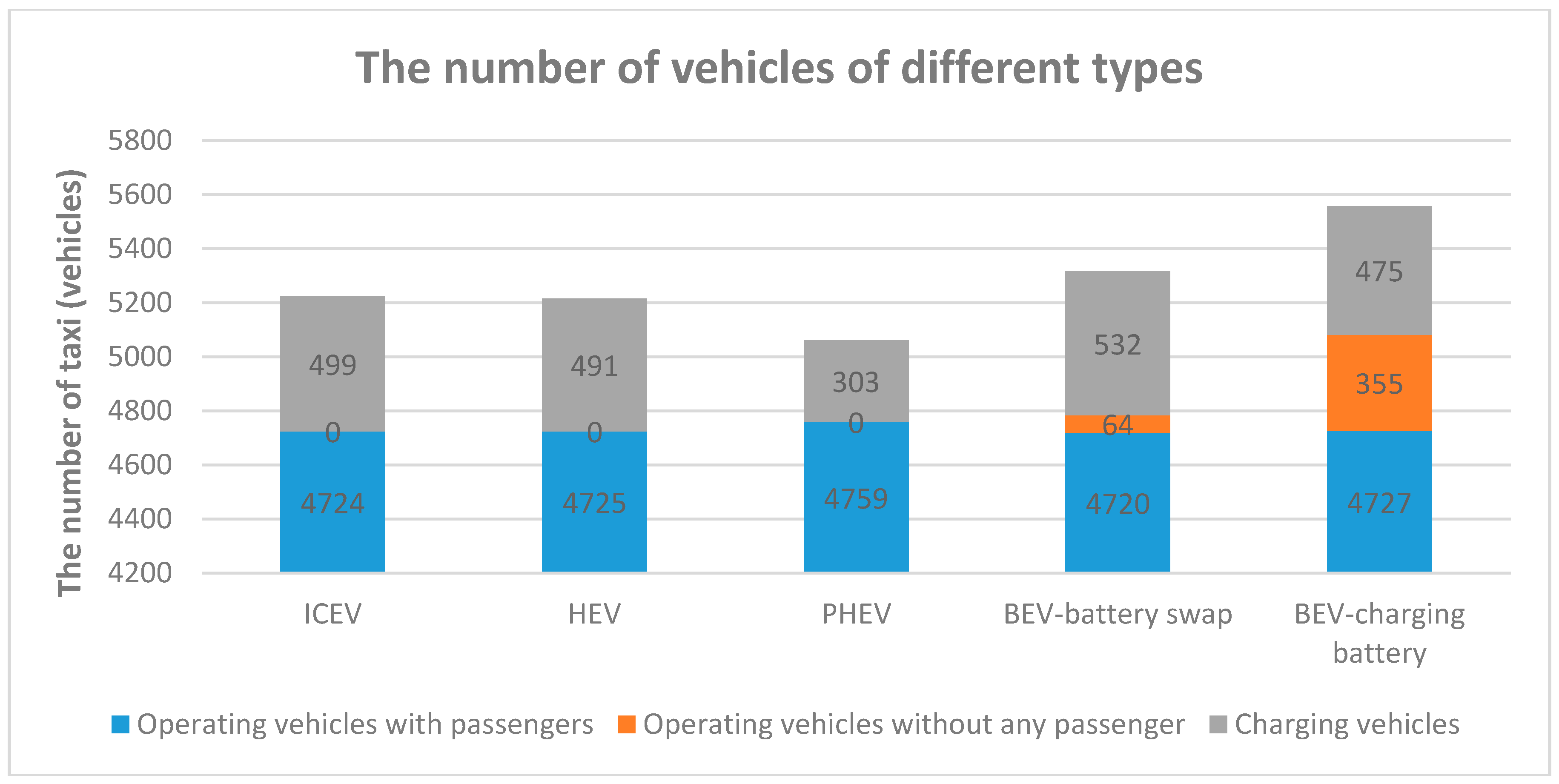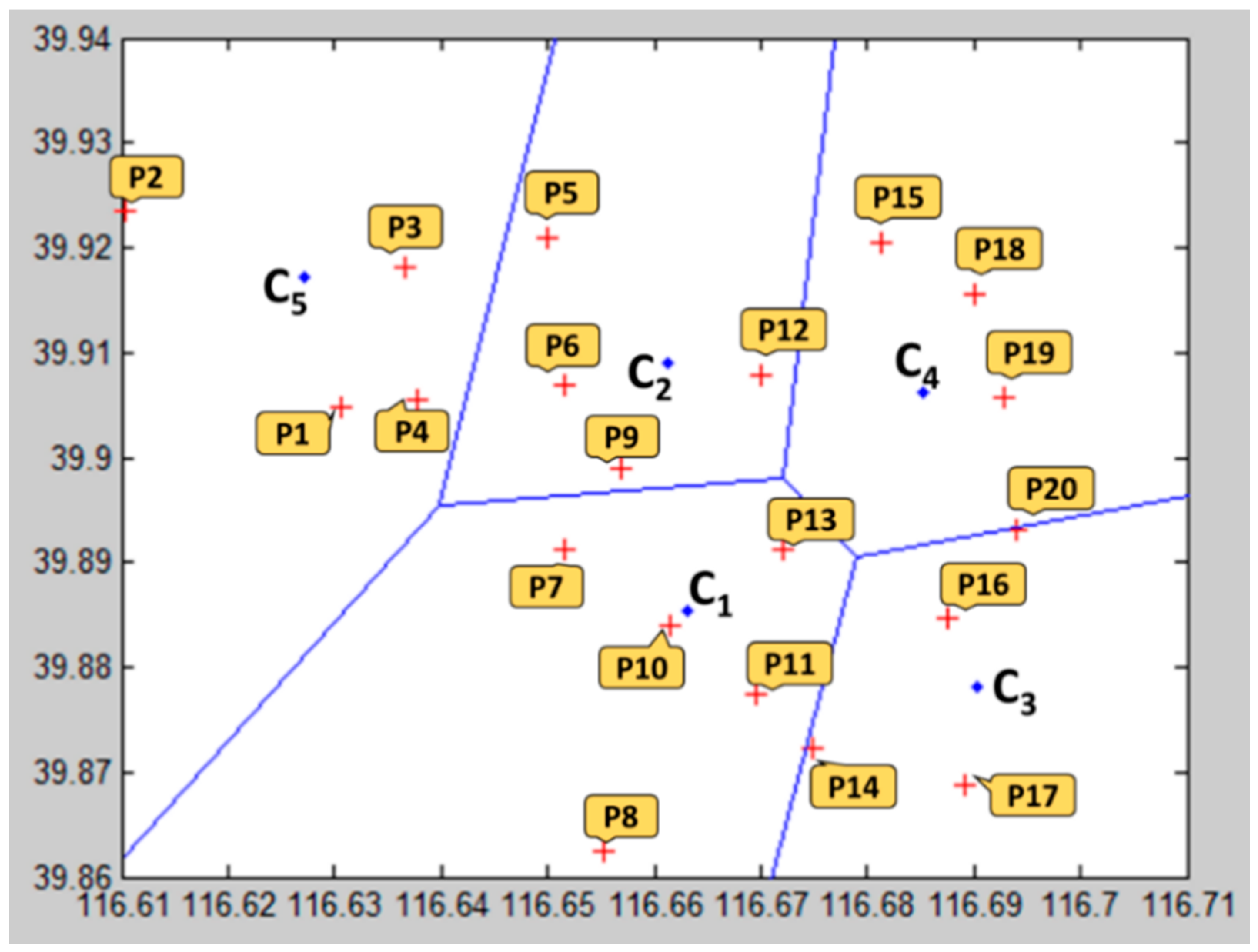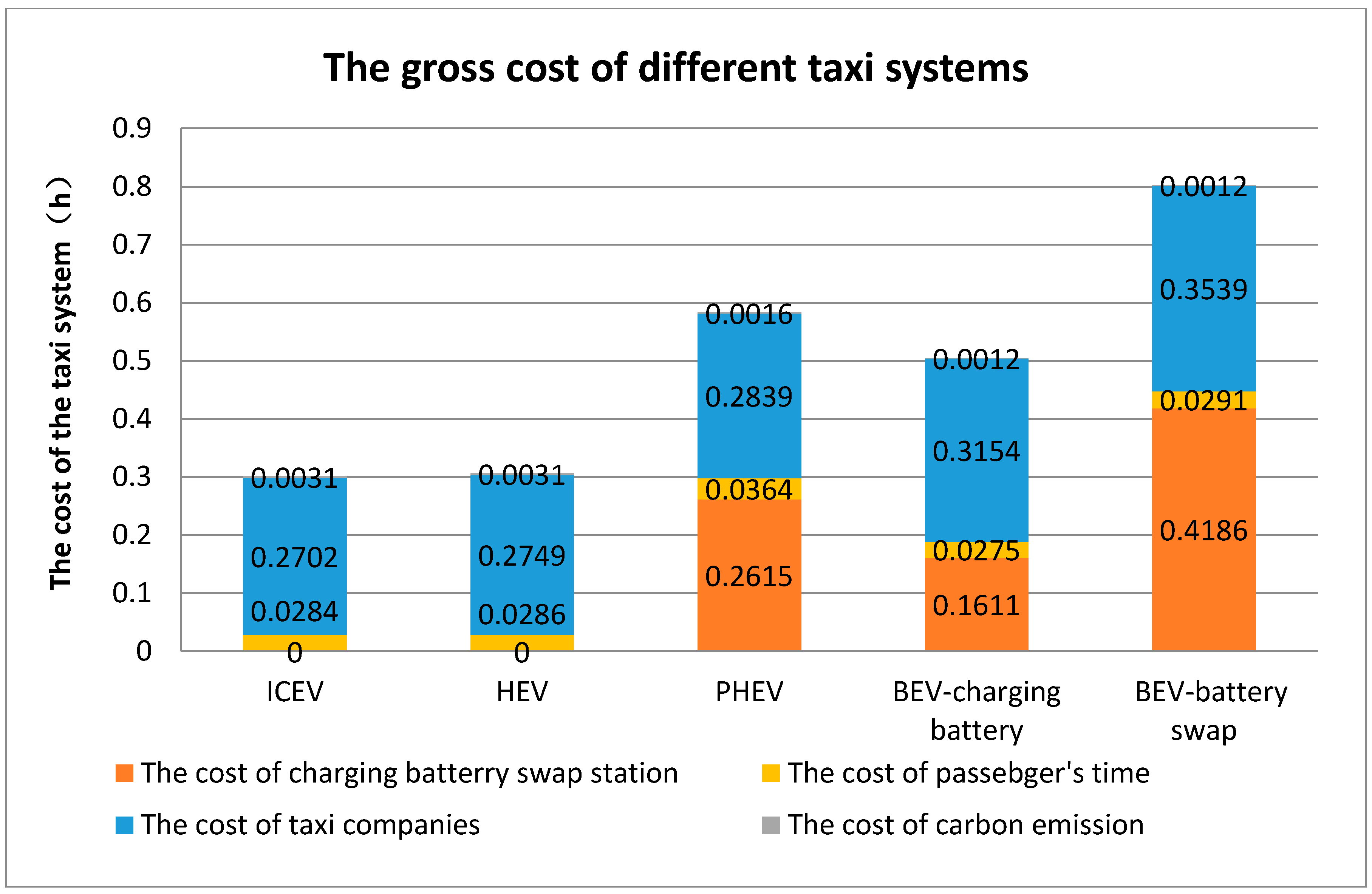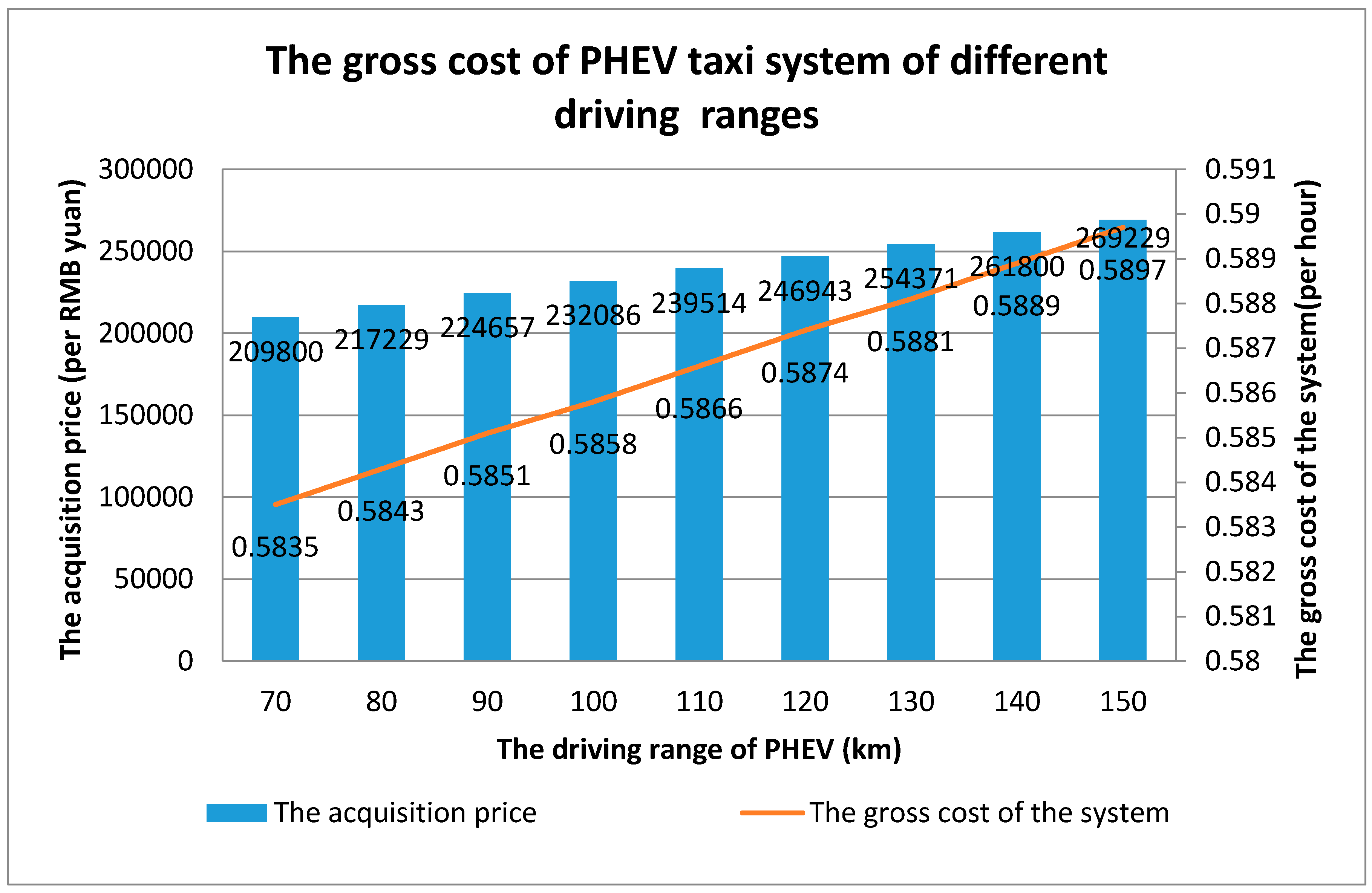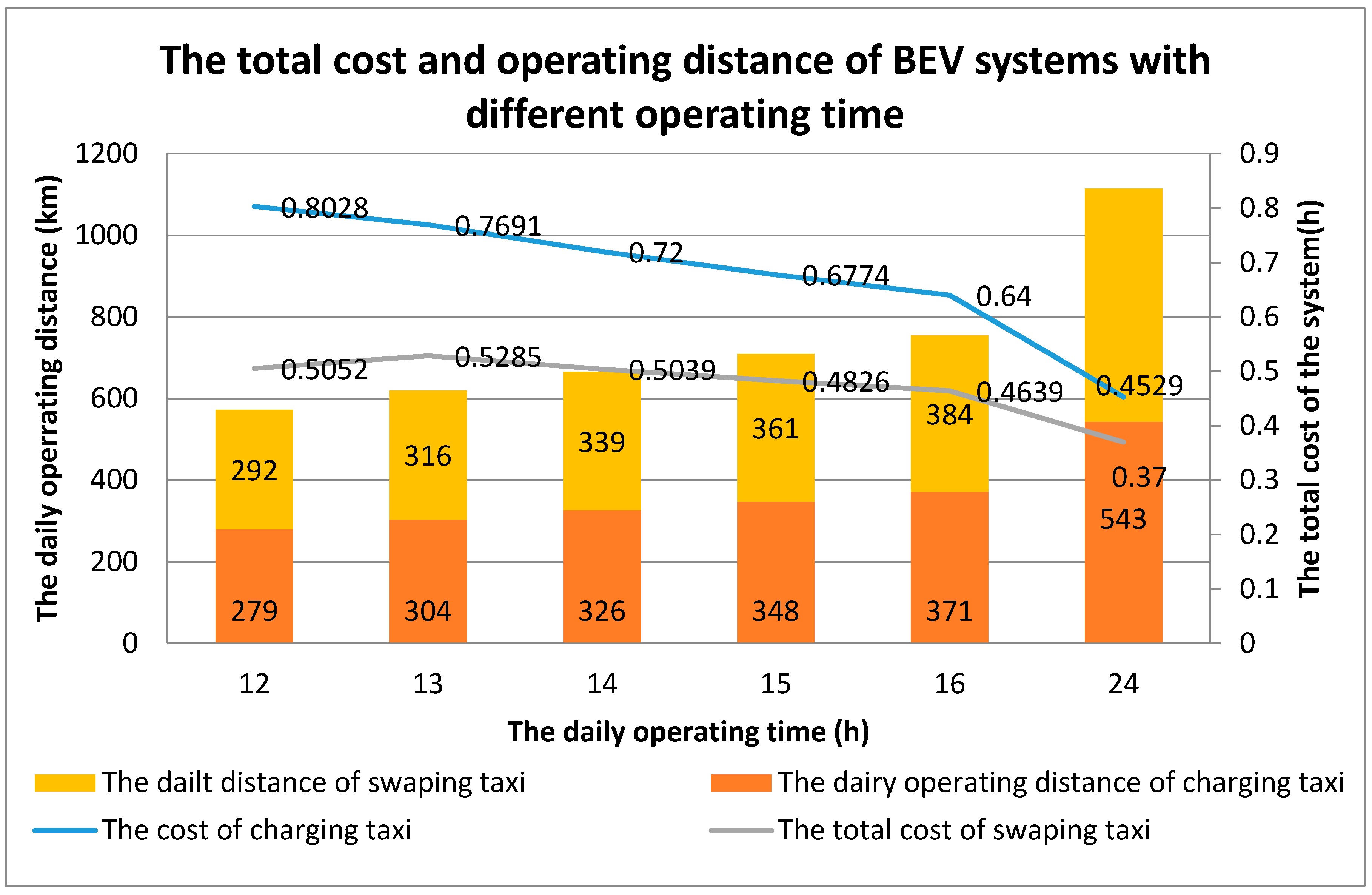The four unique taxi types, drive-ICEV, HEV, PHEV, and BEV, are chosen to make the comparison and analysis of their system costs.
Aimed at achieving the minimum total cost of electric vehicle taxi systems, and the realization of an optimal design model of electric vehicle taxi systems, this paper does not take into consideration the profit situations of vehicle taxis or the charging or battery swap stations.
4.1. The Cost Optimal Model of Electric Vehicle Taxi Systems
The cost of electric vehicle taxi systems can be divided into the four following units: the cost of electric vehicle taxi companies, the cost of charging or battery swap stations, the cost of passengers’ time, and the cost of emission. The cost of charging or battery swap stations is not included in the cost accounting of ICEV and HEV. Due to the fact that the cost of passengers’ travel is measured in hours, all the costs mentioned in this paper will be converted to and measured uniformly in a similar way.
- (1)
The cost of electric vehicle taxi companies
The cost of electric vehicle taxi companies includes two sections. The first is the cost of energy consumption and taxis maintenance, both of which are related to the taxi’s travel distance, called the distance cost. The second one is the cost of the company’s daily operation and taxi depreciation, both of which are related to time, thus we call it the cost of operating hours.
The operating cost of ICEV, HEV, and PHEV taxi companies can be calculated with the following equations:
In the formula, is the cost of electric vehicle taxi companies, and its unit is hour. is the factor of distance cost, and its unit is . is the factor of cost of operating time, and its unit is hour/one car. M is the total number of taxis and its unit is the numbers of cars. is the number of cars carrying passengers and its unit is the number of cars. is the number of cars for hire and its unit is the number of cars. is the time spent in carrying one passenger and its unit is hour. is the distance of carrying passengers and its unit is km. is the distance of picking up passengers and its unit is km. is the cruising distance and its unit is km. is the percentage of passengers waving their hands on the street for taking cars. is the time of getting on a car and its unit is hour. is the time of getting off a car and its unit is hour. is the average travel speed of carrying passengers or picking up passengers, and its unit is km/h. is the average travel speed of cruising and its unit is km/h.
The factor of distance cost
is:
In this formula, is the costs for vehicle fuel and its unit is RMB/km. is the costs for vehicle maintenance and its unit is RMB/km. is the value of per hour (per capita GDP/the average working hour annually), and its unit is RMB/h. means the passengers’ travel demand and its unit is one person*one time/h.
The factor of cost of operation time
is:
In this formula, is the daily operating cost of the companies and its unit is RMB/h. means the taxis depreciation and its unit is RMB/h.
The operating cost for BEV taxi company is:
In this formula, is the total amount of time spent in rooms for charging or swapping batteries twice (including the time for charging and swapping battery) and its unit is hour. is the number of vehicles for charging. is the amount of serving numbers for carrying passengers in rooms for charging or swapping batteries. is the driving range of electric vehicle taxis and its unit is km. is the distance for charging and its unit is km. is the time for charging or swapping batteries and its unit is hour.
- (2)
The cost of charging or battery swap stations.
The cost of charging or battery swap stations includes two subparts. The first is the construction cost of charging or battery swap stations, centering on construction, power distribution system, and monitoring communication system. The second is the construction cost of the charging potential or battery swap potential, centering on charging equipment, and battery replacement system. ICEV and HEV do not need to charge. Both of the construction costs of charging or battery swap stations and the construction costs of charging potential or battery swap potential are zero, and the construction cost of charging or battery swap stations is shown in
Figure 3.
The cost of charging or battery swap stations of BEV:
In this formula, is the cost of charging or battery swap stations and its unit is h. is the factor of the cost of charging or battery swap stations and its unit is h/each station. is the factor of the construction cost of charging potential or battery swap potential and its unit is h/each potential. is the number of charging or battery swap stations. is the number of charging potentials or battery swap potentials.
The factor of the cost of charging or battery swap station
is:
In this formula, is the fixed construction cost of charging or battery swap stations and its unit is RMB/(h*one station). is the variable construction cost of charging or battery swap stations and its unit is RMB/(h*one station).
The fixed cost is the construction cost, which belongs to the primary input-cost. The variable cost represents the expenses on equipment maintenance and protection, staff salaries, and ordinary expenditures.
The factor of the construction cost of charging potential or battery swap potential
is:
In this formula, is the fixed construction cost of charging potential or battery swap potential and its unit is RMB/(h*one potential). is the variable construction cost of charging potential or battery swap potential and its unit is RMB/(h*one potential).
The cost of charging stations of PHEV:
PHEV, with fewer demands of charging intensity and without any fixed charging time, only needs to be charged once a day. To cut the cost of constructing stations and to improve the utilization rate of charging stations, this paper makes the assumptions that there is only one charging station for PHEV within the taxi’s service area and the quantity demands for charging potentials is 5% of the total number of vehicles.
- (3)
Time cost of passengers
The time cost of passengers’ travel is the cost of waiting time, and the time for taking a taxi is the same for each type of vehicle, thus it is excluded.
- (4)
Carbon emission cost
Based on the type of GREET, this paper calculates the carbon dioxide emissions of “Well to Wheel, from oil well to vehicle wheel”, thus getting the carbon dioxide emissions directly and indirectly brought by vehicles [
18]. “WTW” from oil well to vehicle wheel includes two phases: the first is from oil well to oil pump (WTP), and the second is from oil pump to vehicle wheel (PTW). The “WTP” is the first phase for the upstream production of fuels, including the exploration, transportation, production, distribution, storage, and filling process of fuels. The “PTW” is the second phase of the downstream stage for the fuel usage by vehicles.
The carbon emission cost of ICEV and HEV is calculated using the following:
In this formula, is carbon emission cost and its unit is h. is the factor of the cost of fuel carbon emission and its unit is .
The factor of the cost of fuel carbon emission
is:
In this formula, is the fuel carbon emission value and its unit is ton/L. is the carbon trading value and its unit is RMB/ton. is the energy consumption that vehicles spent per km and its unit is L/km or kWh/km.
Carbon emission cost of PHEV:
PHEV consumes two kind of energy: gasoline and electric energy, which should be divided to calculate the amount of carbon emission.
In this formula, is the factor of the cost of electric energy carbon emission and its unit is is the ratio of driving distance of PHEV in electric energy to the total driving distance. is the driving range of PHEV in electric energy and its unit is km. is the cumulative time that taxis travel each day and its unit is h. is the number of times for carrying passengers of PHEV each day and its unit is time.
The factor of the cost of electric energy carbon emission
is:
In this formula, is the value of electric energy carbon emission and its unit is ton/kWh.
The cost of BEV carbon emission:
4.2. The Demand Model of Electric Vehicle Taxi
In this paper, flexible transportation model is used to find out the number of electric taxis are needed. Considering that the urban area is square (or round) in the context of elastic transport model and assumed that the empty vehicle in operation is in a stable density state, that is, the passengers’ travel demand in the system is equal to the empty car rate as well as the rate of carrying passengers, thus we can use the smallest number of taxis to meet the passengers’ travel needs of the whole city. Thus the following equation is obtained:
In the formula, is the passengers’ travel demand, is the empty car rate, means rate of cars with passengers, and their unit is: one person*one time/h.
- (1)
The demand model of ICEV, HEV, and PHEV taxis
There is no limitation to the driving range of HEV and PHEV, which means they are the same as ICEV. Therefore, the demand model of all of the three can be expressed with the same equation.
The empty car rate of taxis is equal to the number of empty cars divided by the driving time of empty cars:
The taxi’s rate of carrying passengers is equal to the number of cars carrying passengers divided by the driving time of cars carrying passengers. The driving time of cars carrying passengers consists of four parts: on-board time, get off time, pick-up time (pick-up distance divided by pick-up speed), and the time of carrying passengers (distance of carrying passengers divided by speed of carrying passengers). Since there is little difference between the speed of picking up passengers and that of carrying passengers, the average speed of carrying passengers is calculated in this paper via the following:
According to the fact that passengers’ travel demands are equal to the empty car rate of taxis and the car rate of carrying passengers, we can draw the following conclusion:
- (2)
The demand model of BEV taxis
Because the driving time of BEV empty cars includes the driving time and cruising time of departing from charging or battery swap stations, the empty car rate of BEV equals to:
The calculation method of car rate of carrying passengers of BEV is the same as that of ICEV:
Simultaneously, in order to keep the empty vehicle in a stable density state, it is necessary to ensure that the vehicles for charging or battery swap stations can fill up the vehicles leaving the charging or battery swap station in time, that is, the charging or battery swap rate is equal to the empty car rate. The charging or battery swap rate is equal to the number of cars of charging or battery swap divided by the average time, which was distributed by the total time of charging or battery swap to each passenger service:
In this formula, is the rate of charging and battery swap and its unit is one person*one time/h.
According to the elastic transportation model, it is evident that passengers’ travel demand is equal to the empty car rate, the rate of carrying passengers, and the rate of car charging and battery swap:
According to the number of empty cars, we can get the average spacing of empty cars:
In this formula,
is the average spacing of empty cars and its unit is km.
is the coefficient of non-linear roads, and different roads have different values from the Internet [
19].
is the whole serving area of the taxis, which is the city area and its unit is km
2.
According to what is mentioned in the literature [
20], the average waiting time of passengers follows the exponential distribution
and the pick-up speed equals the speed of carrying passengers, both of which are constants, so the distance of picking up passengers also abides by the exponential distribution. The average waiting time for passengers is almost the same as the interval of the appearance of two empty vehicles [
21]. According to the average intervals between the empty vehicles, the mathematical expectation of picking up passengers is:
The distance of carrying passengers has nothing to do with the type of vehicle but is rather decided by the trip distance of residence. So in this paper, the distance of carrying passengers is acquired according to data of actual survey.
By combining Equation (21) and Equation (28), we can obtain the cruising distance is:
4.3. The Optimal Design Model of Charging Facilities of Electric Vehicle Taxi
The charging spots of electric vehicle taxis are usually in the vicinity of the intersection of the road network. In this paper we assume that charging demands occur in the near of the road network in the nearest road network intersection. Considering that the number of electric vehicle taxis is fixed, the number of average daily charging times of the city is:
In this formula, represents the total daily charging times of cities and its unit is one car*one time/one day. is the probabilities by charging k times. is the highest frequency that one car can get charged in one day and its unit is one car*one time/one day.
Combined with the operating range of electric vehicle taxis, the intersection of the operating range is selected to serve as the charging demand point, where
(
j = 1, 2, 3 ...,
n) is the charging demand point
j. According to the proportion of traffic flow at each intersection to the total traffic flow ratio of the entire electric vehicle taxi operating range, we get the average number of daily charging at each intersection:
In this formula, is the number of average daily charging at the charging demand point and its unit is one car*one time/one day. is the total traffic flow in all directions of the intersection at the charging demand point , in which = 1, 2, 3 …, n,and its unit is the number of cars/day.
Voronoi diagram is an important algorithm in GIS spatial analysis. It successfully solves the problem of finding the nearest point and shortest path of charts in computers. The principle of the Voronoi diagram can be described as the distance from the arbitrary point in the Voronoi diagram polygon to the center point of the Voronoi diagram polygon if it is shorter than the distance of any other point to the center of the Voronoi diagram polygon. The center point is the generatrix of the Voronoi diagram polygon, and the generatrix of each space corresponds to one single Voronoi diagram polygon [
22].
Definition: In a two-dimensional Euclidean plane, when the discrete point set
,
, we will get:
In this formula, the distribution of and is the Euclidean distance that any point X is to points and its unit is km. In addition, the given plane segmentation can be expressed as a Voronoi diagram, with being the generatrix.
This property of Voronoi diagrams is similar to the concept of the charging service range of electric vehicle taxis [
23]. In the urban road network, the collection of charging and battery swap stations of electric vehicle taxis can be seen as a discrete point, which is the generatrix, on the plane. As a result, we can draw the Voronoi diagram and achieve the full segmentation of the charging service scope. Therefore, the distance of any charging demand point in some charging service scope to the charging and battery swap stations is shorter than that to any other charging and battery swap stations. As for the driver, the only way to decrease the charging distance and time spent in the charging distance to the charging and battery swap stations, corresponded with the charging demand point when the charging demand is generated in a certain charging demand point.
According to the distribution of the charge demand points, it is possible to determine the Voronoi diagram, which considers the charging and battery swap stations as the generatrix, and further determines the charging demand point in each charging service scope
. It is stipulated that when the charging demand point
generates the charging demand, it can only go to the corresponding charge and battery swap station
. In order to better determine the spatial distribution and the service scope of charging facilities, an optimal design model of charging facilities, taking the distance cost of drives and the cost of charging and battery swap stations as the objective function, is established, based on the location planning of charging facilities in the Voronoi diagram, that is, the optimization of the distance cost and the charging and battery swap station cost of the costs of the taxi company in
Section 4.1.
The charging distance of electric vehicle taxis:
In this formula, means the Euclidean distance between charging demand point and the charging and battery swap station and its unit is km.
4.4. The Optimal Design Model of Electric Vehicle Taxi Systems
Based on meeting passengers’ travel demands and the charging demand, this model is intended to calculate the number of empty trucks, passenger cars, storage battery cars, and charging and battery swap stations that should be configured in the whole electric vehicle taxi system, and to determine the location of the charging and battery swap station. Through constant optimization, we hope to minimize the total cost of the electric vehicle taxi system.
The objective function optimized in this paper is the minimum cost of electric vehicle taxi systems, and the equation of the objective function is:
By simplifying Equations (37)–(49) into Equation (36), we can obtain the simplified objective function, which only contains the two variables . The other parameters are already known. In order to get the design of electric vehicle taxi systems with minimum cost, what is needed is to constantly optimize the number of empty cars, charging and battery swap stations, and the station locations.
The way to get the objective function of ICEV, HEV, and PHEV, is the same as that of BEV taxi, and their variables are also after simplification, thus we do not list them here.
